Jwara Langhana, Ghrita, Ksheera Prayoga
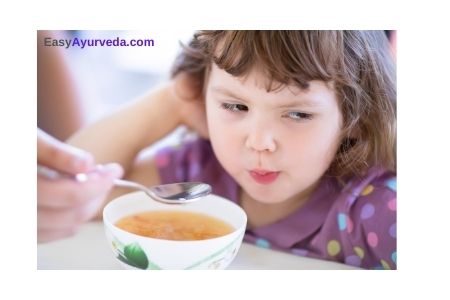
By Dr Raghuram Y.S. MD (Ay) & Dr Manasa, B.A.M.S
Langhana means treatments which bring about lightness in the body. It forms the first line of treatment in fevers, in acute fever i.e taruna jwara to be precise.
Table of Contents
Langhana in Jwara
Langhan Definition
‘Anything which brings about lightness in the body is called as langhana’.
Taruna Jwara – translates to young fever. This implicates to the fever in its initial days of manifestation. Fever for the first 7 days is called as taruna jwara. This term can also be used to explain the acute fevers.
Read – Langhana Therapy – A Unique Ayurvedic Treatment Principle
Why should Langhan be administered in Fever?
Pathogenesis of fever as explained in Madhava Nidana treatise –
‘In persons consuming incompatible and unwholesome foods and activities, the doshas get vitiated and get lodged in the stomach. These doshas then throw out the gut fire (weaken the digestive fire) and cause fever travelling through the rasa carrying channels’.
Read – Rasa Dhatu: Definition, Formation, Circulation, Imbalance Diseases, Treatment
According to this reference the site of origin of fever is stomach (and intestine).
And for all those diseases taking their origin from the stomach Langhana – fasting is the first medicine. Therefore Langhana is an important therapeutic strategy in the treatment of fevers.

Langhana – the first line of treatment in fever
Langhana should be the first line of treatment once the fever gets manifested.
Langhana should not be administered in fevers caused by –
- Depletion of tissues – kshaya
- Vata – Anila
- Fear – Bhaya
- Anger – Krodha
- Desire, lust -Kama
- Grief – Shoka
- Exhaustion -Shrama
Some have opined to take kshaya and anila together. This forms kshayanila. This means ‘in fevers caused by vata aggravated due to the depletion of tissues’.
Read – Decrease Of Tissues – Dhatu Kshaya – Reasoning, Symptoms
Other contraindications
- Manasa Jwara – fevers caused by mental imbalance (Sushruta)
- Urdhwa Maruta – Vata having upward course of movement
- In presence of thirst
- In presence of hunger
- In presence of mouth dryness
- Giddiness
- Pregnant woman
- Old aged
- Children
- Debilitated persons
- Fearful persons
Extra contraindications mentioned by Master Vagbhata (A.Hr.Chi.1)
- Shuddha Vata – fevers caused by vata not associated with ama
- Agantu jwara – fevers caused by external factors
- Jirna Jwara – fevers not associated with ama (those which have surpassed the taruna jwara stage)
Read – Use Of Water In Fever, Rules, Method, Ayurveda Perspective
Contra indication in fevers caused by desire, grief etc.
In each of the above enlisted condition contraindicated for fasting, there will definitely be association of vata over a period of time. Therefore if fasting is done in fever caused by these factors it will further vitiate vata and cause complications and hence should not be advocated.
Before knowing which type of langhana should be used and in what way, we need to first check upon the types of langhana.
Types of Langhana
There are 10 types of lightening therapies, as mentioned below –
- Emesis
- Purgation
- Decoction enema
- Head cleansing through nasal drops
- Withholding the urge of thirst
- Exposure to wind
- Exposure to sunlight
- Ama digesting medicines
- Fasting
- Exercise
Should all types of Langhana be administered in Fever?
Master Chakrapani clarifies this doubt by telling that ‘in treatment of fever, langhana means anashana or upavasa’. This means to tell that in acute fevers the treatment should be started with ‘fasting’. This also means that the other forms of lightening therapies should not be administered during the first 6-7 days of fever.
Read – How To Do Fasting? A Step By Step Guide For You
What about other forms of Langhana?
The four types of shodhana i.e. purifying measures included in langhana – emesis, purgation, decoction enema and head cleansing are administered in fever but not in acute fevers. Since they are administered conditionally as and when needed, they are not desired in the initial stages of fever.
Exposure to wind and exercise are as such contraindicated in newly manifested fever.
Since use of hot or cold water and medicated water are advised in fever as per the condition of fever and dosha involved, withholding the urge for thirst is not an option in acute fevers.
Since all fevers are associated to variable amounts of temperature differences exposure to the sun is contraindicated.
Pachana is explained as a treatment strategy in later conditions of fever and should be done after langhana.
So, among the 10 forms of langhana only fasting is left over and that alone should be administered at the beginning of the fever, as initial intervention.
But therapeutic emesis has been explained in taruna jwara…?

In the context of prescribing yavagu i.e. different kinds of gruels for patients of fever, master Charaka tells that ‘Gruels should be administered in proper time to a patient who has undergone emesis and fasting’.
This is one of the treatment principles in acute fevers. But we already have seen that apart from fasting no other forms of langhana, including emesis (which is a type of langhana as already mentioned) should be administered in the first 6-7 days of fever.
But in this verse the chronology puts fasting after emesis making emesis as the first choice treatment in the treatment of taruna fevers.
Before deciding if emesis is the first line of treatment in acute fevers, let us see the conditions in which emesis should be administered in taruna fevers?
Emesis should be administered in a patient suffering from acute fever only when the below mentioned conditions are available –
- Predominant vitiation of kapha in the stomach
- Doshas (kapha predominant doshas) showing signs of preparedness of getting expelled out i.e. signs of excitation like nausea etc
- Doshas should have been located in the stomach
The physician having considered these doshas as causal for acute fever should administer emesis to the eligible patients in proper time, using proper and comprehensive emetic formulations. After emesis, fasting should be started. If there are no signs of kapha aggravation or excitation treatment should be started with fasting.
Master Harita too tells – ‘Emesis should be administered at the beginning to expel morbid pitta and kapha’.
Here ‘at the beginning’ does not imply to ‘at the beginning of fever’. It is conditional. Emesis should be administered at the beginning of pitta and kapha type of fevers, that too if there is severe exacerbation of these doshas. This rule is not applicable to all kinds of fevers.
Therefore langhana itself stays as the prime treatment strategy in fevers.
Read – Ayurveda Lifestyle and Diet For Fever – 45 Important Things To Know
Langhana or Vamana – Which is the first choice in treatment of acute fevers?
Without any doubt fasting is the first choice of treatment during the first 6-7 days of fever. Administering emesis is conditional.
Rule 1 – The earlier stages of fever are associated with symptoms of ama. The doshas causing fever too are associated with ama. In such conditions the treatment should be initiated with lightening therapies in the form of fasting (to one’s capacity). The other condition for starting the treatment with fasting is ‘absence of kapha aggravation or presence of excited kapha in the stomach’. Here fasting forms the first line of treatment for acute fevers.
Rule 2 – There is every chance that kapha predominant symptoms as evidenced by the presence of ‘signs of eligibility for emesis in fever’ as highlighted above are present right at the beginning of the fever. This is also true because stomach is the origin for both fevers and kapha. In such condition advising the patient to fast or starve will not help. This is because of presence of abundance of kapha predominant doshas in an excited state waiting to be expelled from the stomach. Here if you administer fasting it might not be sufficient to expel the aggravated kapha.
As a rule, when doshas are present in excess, lightening therapies should be given in the form of purifying therapies, emesis in this context.
Once the kapha has been expelled we can come back to the principles of treating acute fevers and advise ‘fasting’ as the immediate next measure. Fasting – further helps to dry off the kapha which has not been expelled through emesis. Here the treatment starts with emesis and continues with fasting. This justifies the statement made by Charaka in the context of ‘administration of yavagu’.
As per master Harita, emesis can be the first hand treatment in kapha predominant and pitta predominant fevers.
Pachan should be given first in fevers?
In Charaka Sutra Sthana section, Chapter 22, verses 20-21, Master Charaka enlists some diseases having moderate strength in which Pachana should be administered as ‘first line of intervention’. Fever is also counted among them. According to this reference, Pachana should be given first in treatment of fever. In the Chikitsa Sthana, Charaka tells that Langhana should be given as ‘first line of intervention’. These two references create confusion and are mutually contradictory.
Master Chakrapani gives clarification for this and tells –
‘Pachana should be administered before starting the medicines (applies to the reference quoted in Sutra Sthana) but not at the beginning of fever’.
This sums up into the below mentioned conclusions –
- At the beginning of fever (initial days of acute fever) – langhana (fasting) should be administered
- At the beginning of medicines (prior to administration of oral medicines) – pachana should be administered
Therefore the reference from Sutra Sthana will not be applied in this context.
Read – When To Stop Fasting? Warning Symptoms To Watch
Langhana shall be administered in fevers caused by Margavaranajanya Vata
We have seen that fasting should not be administered in case of vataja type of fevers. Fasting should not be administered in ‘Nirama Vata’ condition i.e. wherein vata is not associated with ama.
Vata aggravates due to two reasons –
1. Dhatu Kshaya i.e. depletion of tissues –
As discussed earlier when fever is caused by vata aggravated due to depletion of tissues, then fasting should not be advised.
2. Margasya Avarana i.e. obstruction to the movement of vata caused by enveloping of vata –
Master Chakrapani tells that in ‘fevers caused by vata aggravated due to its passage routes being blocked’ langhana – fasting shall be given. Since the vata is aggravated due to it being enveloped by other dosha or vata subtype itself, the pathology is similar to vata being associated with vata (the enveloping material by nature acting like ama). Since this condition is similar to sama vata i.e. vata associated with ama, fevers caused by such enveloped vata are eligible for ‘fasting as langhana’.
Read – Mechanism Of Avarana, Types, Importance of Vata
Langhana in Sama Vata
Langhan – fasting also needs to be administered in sama vata or fevers caused by vata associated with ama.
Master Chakrapani further states – ‘in fevers caused by vata associated with ama, langhana can be skillfully given for the digestion of ama, but not as aggressively as in kaphaja type of fever’.
Kapha and ama are said to possess similar properties and are also similar in nature. In fevers caused due to kapha, if kapha is severely aggravated and excited, emesis should be administered followed by fasting. But if kapha is not severely aggravated and not excited, only langhana should be administered that too intensively. Contrary to this, in fever caused by sama vata intensive fasting as given in kapha type of fever should not be given because once the ama is destroyed, intensive fasting will aggravated vata. So in fevers caused by sama-vata fasting should be judiciously administered.
Read – Sama and Nirama Vata: Association of Ama With Morbid Vata
Can Langhan be administered in Jirna Jwara?
Jirna Jwara is a status of fever wherein it has surpassed the acute stage (taruna jwara). Jirna means digestion or digested. The fever is called so because the ama associated with the doshas in the earlier days of fever have been digested and the doshas are free of ama in this stage.
Fasting as a rule should only be administered in taruna jwara when there is association of ama. In Jirna Jwara fasting is strictly contraindicated due to the absence of association of ama.
Master Vagbhata further clarifies this principle telling – ‘Langhana should not be administered in fevers caused by only vata (not associated with ama), tissue depletion and in jirna jwara. In these conditions shamana i.e. palliative treatments which do not cause emaciation should be done’.
Can light food be given in acute fevers?
In Charaka Nidana Sthana section, Master Charaka tells that in fevers either light food or fasting should be advised. Master Chakrapani clarifies this by telling that light food should be given only in the premonitory stage of fever when fever has not yet been manifested. But once the fever has been manifested fasting alone is desirable. Therefore even light food is contraindicated in taruna jwara.
The only form of food that the person receives during acute fevers is yavagu i.e. different kinds of gruels. Even here gruels are not given as food, they are given as dietetic supplements to provide energy and support life for those who are fasting and also with an intention of digesting the ama associated with doshas (therapeutic action). Gruels are prepared with antipyretic herbs. Therefore gruels are not counted as food.
Read – Yavagu – Preparation, Benefits, Uses In Fever
Benefits of Langhana
- Dosha kshaya – depletion of the fever causing doshas (and ama)
- Sandhukshite anale – as a consequence of this, the digestive fire gets kindled
- Vijwaratvam – fever gets subsided
- Laghutvam – lightness is experienced in the body
- Kshudha – the person starts feeling hungry and becomes desirous of food
Limitations of Langhana
The physician should know the limitations of administering fasting therapy. The fasting should be planned in such a way that it doesn’t interfere with life and life activities. Health is abode of strength and energy and treatment is done only to establish a healthy condition in the body and not to pose threat to the life.
Fasting should be administered to a patient of fever until the doshas are obstructed and are moist and motionless.
In a person in whom the doshas have been obstructed, apatarpana i.e. fasting should be advocated after having considered the status of dosha and life in order to pacify the aggravation of doshas.
Langhana as Pachana
Langhana has a dual role. Apart from causing lightness in the body it also acts like Pachana i.e. an effective ama-destroying measure. Therefore Langhana is also extended into the next schedule of the treatment but in the form of one of the kinds of Pachana.
Sanskrit Verses
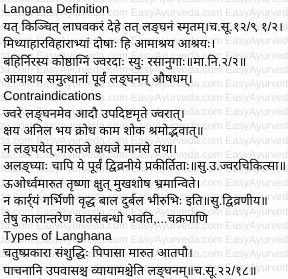
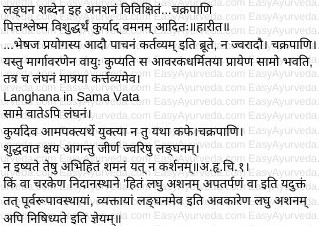
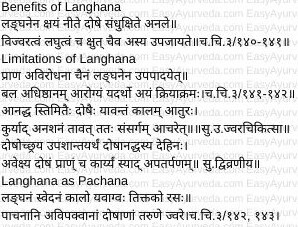
Ghrita Prayoga in Jwara
Use of ghee is one of the important measures mentioned amongst the treatment principles of jwara (fever). Ghee / medicated ghee is an important medicine in the treatment of fevers but cannot be used in all patients and in all conditions of fever. It also cannot be used in all stages of the fever and in all kinds of fevers. This shows that the use of ghee in the treatment of fever is elective and conditional.
Read – Ayurveda Lifestyle and Diet For Fever – 45 Important Things To Know
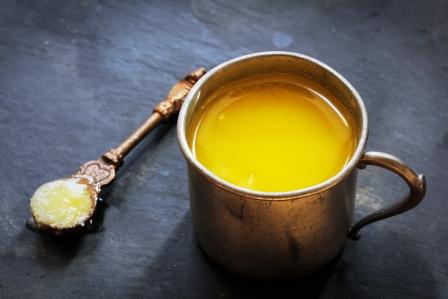
Master Charaka has given a comprehensive protocol for treating fevers – according to the stage of the fever and type of fever. The ‘fever treatment’ protocol given by Master Charaka has a typical chronology. Every treatment mentioned in the lineage of chronology has inclusion and exclusion criteria and certain conditions which apply, which is true for the use of ghee also. In this article will touch upon the use of ghee in the treatment of fever and where exactly it plugs into the chronology of ‘fever treatment principles / protocol’ and conditions applied for using the same.
Read – Jwara Pravritti – The Initial Manifestation
Ghee in treatment of fevers
Ghee shall be used in the treatment of fevers after the first 10 days of manifestation of fever, after the measures for digesting ama and kindle the digestive fire have been implemented in the taruna jwara stage (the first 6-7 days of the fever, acute phase of the fever). This means to tell that ghee shall be used in the jirna jwara i.e. the stage of fever wherein ama has been got rid of.
The conditions are –
- At urdhwam – after 10 days of manifestation of fever
- Vatapittottara jwara – The fever predominantly caused by aggravated vata, pitta or vata and pitta
- Kaphe Mande – kapha is mild or its association with vata and pitta in the fever
- Paripakveshu dosheshu – when the doshas have been totally digested (got rid of association of ama totally)
When ghee is administered adhering to the above mentioned conditions, it would act like amruta – nectar for those suffering from fever. This means to tell that ghee, in the treatment of fever (would act like a rejuvenator, cures the residual fever and boosts up the strength and energy.
Read – Ghee Benefits, Usage, Side Effects, Contra Indications
Kaphe mande
It is important to note that ghee is very useful in vata-pitta fevers but the other part of the condition is that there should be less or no association of kapha in the fever. It also means that ghee shall be given in fevers having less kapha aggravation or mild kapha aggravation. If the morbid kapha is absent ghee can be readily administered in vata, pitta and vata-pitta types of fever.
It is quite natural for kapha to regress by the 10th day in fever (due to earlier treatments)
It is assumed that if proper line of treatment and chronology is followed, kapha will regress itself within the first ten days after the onset of the fever. Lightening therapy, emesis, sudation, use of yavagu gruels, bitter tasting herbs and their recipes, use of decoctions and the time period of 10 days itself will help in combating ama and kapha within 10 days. Due to the effect of temperature of fever and some of these therapies dryness of tissues too would occur while giving scope for aggravation of vata and pitta. With depletion of tissues and increase of vata and pitta and with impact of fever, the person would also feel tired and worn out. So some supportive medicine which is also a food and nutrition is needed. All these events will create a suitable premise for the use of ghee in this stage of fever.
Read – How To Consume Ghee Based on Tridosha Imbalance?
Ghee as a diet in fever treatment
If we carefully look at the context wherein the use of ghee in fever has been first mentioned by Master Charaka we can note that it has been explained during the context of ‘dietetic recommendations’ for the patients of fever. It is interposed between the explanations of ‘use of yusha – soups’ and ‘use of mamsarasa – meat soup’ in the treatment of fever. This also means to tell that Master Charaka has considered ghee as not only medicine but also as a diet in the treatment of fever. In the context of ‘Achara Rasayana’ in the first chapter of Charaka Chikitsa, Master Charaka has mentioned ghee as a nitya rasayana i.e. ‘a rejuvenator which can be used on daily basis’. This explains how important the ghee is in the treatment of fevers.
The other forms of ghee should not be administered
While administering ghee or medicated ghee through oral route in fevers it is equally important to note that ghee in the form of unctuous enema should not be used simultaneously. Administration of fats or medicated fats in more than one route of administration is contraindicated. So when oral ghee is being given, the administration of the same through anal route shall be avoided. Similarly ghee shall not be used for massage.
Exception in administering ghee in fevers
Even after 10 days of treatment of fever if there is predominance of kapha i.e. if kapha has not regressed and if the signs and symptoms of langhana therapy are not found which indicates the incomplete removal or expulsion of ama and kapha ghee should not be administered for consumption.
Why hasn’t the kapha been brought to control in these conditions?
- Due to the fevers being caused by doshas having severe association of ama (wherein in spite of all treatments the ama is still remaining in the body and hasn’t cleared out, due to its abundance) and
- Due to improper treatment administered during the taruna stage of fever (first 7-8 days of fever)
What to do in these cases?
In these cases ghee should not be administered. Instead kashayas i.e. herbal decoctions shall be administered so as to combat the residual kapha. Kashayas shall be given until the excessive kapha brought to balance and until the person feels lightness in the body. But if kapha has been depleted due to the impact of earlier treatments and if signs and symptoms of langhana are evident ghee shall be administered without hesitation.
Read – Use Of Herbal Decoctions In Fever -Kashaya In Jwara
Ghee, an ultimate medicine in treating fevers (conditions apply)
Ghee should be liberally administered in the treatment of fevers in those people –
- whose fever has not come down in spite of administration of herbal decoction, emesis, lightening therapy and light to digest food and
- those who have developed dryness in their body
Ruksha teja i.e. pitta devoid of watery content i.e. dry pitta causes fever. This teja i.e. heat would cause dryness of the body. This eventually leads to aggravation of vata. This vata which has increased in the later part of the fever and is associated with pitta shall be counteracted by the administration of medicated ghee, ghee being antagonistic to vata and also to pitta. Thus, ghee or medicated ghee is said to be the ultimate weapon in dealing with vata and pitta types of fevers. Master Charaka tells that the decoctions mentioned in the treatment of fevers shall be taken mixed with ghee. This would not only reduce the fever but will also enhance the appetite and bring the digestive fire to balance. There is nothing as good, as beneficial and as auspicious as ghee in the treatment of fevers. Master Charaka describes the preparation and use of Pippalyadi Ghrta, Vasadi Ghrta and Baladi Ghrta in this context.
Read – Diet and Ayurveda Home Remedy For Fever And Cold
Sanskrit Verses
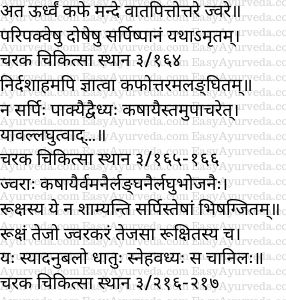
Read – Charaka – Jwara Chikitsa 3rd Chapter
Use of ghee in other types of fever
Sannipataja Jwara
In fevers caused by simultaneous aggravation of all three doshas, when swelling occurs in the root of ear as a complication, oral consumption of ghee has been advised amongst many treatment options.
Vishama Jwara
- Consumption of ghee has been mentioned amongst the treatment options for vataja type of tritiyaka and chaturthaka kinds of irregular fevers.
- Similarly oral consumption of ghee processed with pitta alleviating herbs is indicated in the tritiyaka and chaturthaka kinds of irregular fever caused by predominantly aggravated pitta.
- Use of Shatphala Ghrta explained in the context of Gulma has been indicated for consumption in irregular fevers.
Read – Vishama Jwara Definition, Causes, Types, Symptoms, Treatment
In secondary fevers
In fevers caused by visarpa (herpes), abhighata (injury) and visphota (boils and eruptions, eruptive fevers) – oral consumption of ghee is the first line of treatment, provided if there is no predominance of kapha and pitta in the fever.
Agantuja Jwara
In fevers caused due to external factors, mainly abhighataja jwara i.e. fever caused due to injury – ghee is indicated for oral consumption and for massage.
Punaravartaka Jwara
In recurring fevers, use of oral ghee prepared with bitter tasting herbs has been indicated amongst many treatment options
Formulation for Nava Jwara From Sahasra Yoga Text Book
Ramabana Gutika (Nava Jwara Nivarini)
Ksheera Prayoga In Jwara
Use Of Milk In The Treatment Of Fevers
Ksheera means milk. Milk is a favorite food for many people. It has a wide array of health benefits. But it may not be suitable to all. It is also not suitable in all conditions in a given individual.
Read – Cow’s Milk Benefits According To Ayurveda
Use of milk and medicated milk in fevers
Milk is a good diet as well as a medicine for those suffering from fever. But the milk needs to be administered by adhering to certain conditions mentioned in the treatises. As we know, Master Charaka has given a comprehensive treatment protocol for fever treatment. He has given reasons and conditions for each and every treatment aspect and therapy. He has also clearly indicated the stage in which a therapy or medicine or diet needs to be used and time stipulation regarding the same (until when it has to be used). The same rule applies to the use of milk also.
Let us see where exactly ‘the use of milk’ fits in, in the chronology of ‘fever treatment protocol.
Pre and post context for use of milk
Use of milk in the treatment of fever has been indicated in continuation with the ‘dietetic protocol’ for fever.
Before the mention of milk, Master Charaka hs explained the use of mamsarasa (meat soup), yusha (soups), ghee and laghu bhojana (light to digest foods). After the mention of milk and writing the conditions for its usage Master Charaka explains the conditions for administration of Virechana i.e. therapeutic purgation in the treatment of fevers. He further tells in the context of virechana that ‘when all the above mentioned measures for the treatment of fever fail to yield results or to relieve fever and when the strength, muscles and digestive capacity of the patient are intact, virechana shall be administered’. So, purgation is considered as an ultimate resort to reduce the fever and its intensity when other treatments fail to do so. So, milk has been mentioned just before virechana.
So, use of milk is also considered as an inclusion in ‘dietetic protocol’ in the treatment of fevers, just like meat soup, soups, ghee and light foods. It is also the last in the list of useful diets in fever. The dietetic protocol for fevers has been explained after the administration of initial measures to combat taruna jwara / nava jwara i.e. acute stage of fever or first 6-7 days of fever. They include ‘ama eliminating’ measures like lightening therapies, emesis, sudation, time period, use of yavagu (gruels) and bitter tasting herbs. Thus, though not mentioned, use of milk shall be considered (to be put into use) after the first 6-7 days of fever once the ama has been dealt with and the digestive fire has come to a balance. This also means that milk shall not be used during the first 6-7 days of fever.
Read – Types Of Jwara According To Ayurveda: Jwara Bheda
Sanskrit Verses

Conditions for using milk in fevers
In vata-pitta predominant fevers associated with burning sensation and thirst (or patients with burning sensation and thirst suffering from vata-pitta predominant fevers), in which the doshas have been constipated or are getting eliminated from their seats in small quantities, milk shall be given to conquer the fevers provided that the fevers are devoid of ama (nirama).
Let us split this one now and try to understand the conditions for administration of milk.
Read – 21 Foods That Are Incompatible With Milk
In fevers, milk should be given in the below mentioned conditions –
- Vata pittottara jwara – fevers caused by predominant vitiation of vata and pitta
- Daha trshna paritasya – fevers (vata pitta predominant) associated with burning sensation and thirst
- Baddha dosha – when doshas are constipated (not getting expelled)
- Prachyuta dosha – when doshas are eliminated in small quantities (but not in totality)
- Nirama jwara – fevers (vata pitta predominant fevers) devoid of ama
The milk works in both conditions – when doshas are constipated and when they are getting expelled in small quantities. This is the speciality of milk. Among the properties of milk the below mentioned have been mentioned –
- Purishe grathite pathyam – milk is conducive when the feces is matted / constipated
- Atisare cha pathyam – milk is conducive and is also a beneficial diet in diarrhea (wherein the feces is getting eliminated)
The milk works on the same principles in fevers also.
Milk shall be judiciously administered in fevers.
In constipated doshas – milk should be administered until the doshas get expelled. After that it needs to be stopped.
In doshas which are getting expelled in small quantities – milk shall be administered as a helping agent so as to expel the constipated doshas since the doshas are not getting expelled in totality.
Here we need to understand that milk shall be given in large quantities when doshas are totally constipated and in small quantities when doshas are partially constipated i.e. doshas are getting expelled in small quantities.
Which milk is ideal in these conditions?
Cow milk – shall be administered in constipated doshas. Cow’s milk has laxative property and would help in proper elimination of doshas.
Goat milk – shall be administered in conditions wherein the doshas are getting expelled in small quantities. Goat’s milk is constipating in nature. It helps when doshas are getting expelled frequently and in small quantity.
Utility of milk to expel feces in weak patients
Emesis or purgation should not be administered in those who have got weakened due to fevers. In these patients if feces need to be eliminated, it shall be done by administering milk for drinking. Alternatively Niruha Vasti – decoction enemas shall be administered.
Kshirapaka – processed milk in treatment of fevers
Below mentioned medicated milks are mentioned to be used in the treatment of fevers –Laghu panchamula siddha kshirapaka – Milk processed with lesser five roots is beneficial in treating fevers associated with cough, shortness of breath, headache and also in chronic fevers.
Other medicated milks includes –
- Erandamuladi Kshirapaka – Milk processed with decoction prepared with erandamuladi group of herbs shall be used.
- Bilwa Kshirapaka – Milk processed with pulp of fruits of Bilwa – Aegle marmelos
- Trikantakadi kshirapaka – Milk processed with paste of Tribulus terrestris, roots of Sida cordifolia, Solanum xanthocarpum and Zingiber officinale mixed with jaggery
- Nagaradi Kshirapaka – Cow Milk processed with paste of Zingiber officinale, Vitis vinifera, Dates mixed with ghee, sugar and honey
- Chaturguna Paya – Milk processed with four times water
- Dharoshna Paya – Fresh milk is beneficial for those suffering from fever caused by combined vitiation of vata and pitta
Use of milk in Jirna Jwara – Milk is the best diet and medicine for those suffering from chronic fevers. Milk processed with dosha specific herbs shall be administered cold or hot in accordance to the doshas.
Use of milk in pitta predominant vishama jwara – In irregular fevers caused by vitiation of pitta, milk processed with pitta mitigating herbs has been mentioned amongst the list of useful remedies. Milk, as such is mentioned as a useful diet and medicine for those suffering from irregular / intermittent fevers.
Click to Consult Dr Raghuram Y.S. MD (Ayu)







